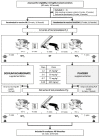The Effect of a New Sodium Bicarbonate Loading Regimen on Anaerobic Capacity and Wrestling Performance
- PMID: 29848993
- PMCID: PMC6024820
- DOI: 10.3390/nu10060697
The Effect of a New Sodium Bicarbonate Loading Regimen on Anaerobic Capacity and Wrestling Performance
Abstract
Gastrointestinal side effects are the main problem with sodium bicarbonate (SB) use in sports. Therefore, our study assessed the effect of a new SB loading regimen on anaerobic capacity and wrestling performance. Fifty-eight wrestlers were randomized to either a progressive-dose regimen of up to 100 mg∙kg-1 of SB or a placebo for 10 days. Before and after treatment, athletes completed an exercise protocol that comprised, in sequence, the first Wingate, dummy throw, and second Wingate tests. Blood samples were taken pre- and post-exercise. No gastrointestinal side effects were reported during the study. After SB treatment, there were no significant improvements in the outcomes of the Wingate and dummy throw tests. The only index that significantly improved with SB, compared to the placebo (p = 0.0142), was the time-to-peak power in the second Wingate test, which decreased from 3.44 ± 1.98 to 2.35 ± 1.17 s. There were also no differences in blood lactate or glucose concentrations. In conclusion, although the new loading regimen eliminated gastrointestinal symptoms, the doses could have been too small to elicit additional improvements in anaerobic power and wrestling performance. However, shortening the time-to-peak power during fatigue may be particularly valuable and is one of the variables contributing to the final success of a combat sports athlete.
Keywords: Wingate test; alkalosis; buffering; combat sports; dummy test.
Conflict of interest statement
I.Ł. receives a salary from the pharmaceutical distributor, who offers different alkali products. However, the content of this study was not constrained by this fact. Moreover, our adherence to
Figures



Similar articles
-
Chronic lactate supplementation does not improve blood buffering capacity and repeated high-intensity exercise.Scand J Med Sci Sports. 2017 Nov;27(11):1231-1239. doi: 10.1111/sms.12792. Epub 2016 Nov 23. Scand J Med Sci Sports. 2017. PMID: 27882611 Clinical Trial.
-
The gender dependent influence of sodium bicarbonate supplementation on anaerobic power and specific performance in female and male wrestlers.Sci Rep. 2020 Feb 5;10(1):1878. doi: 10.1038/s41598-020-57590-x. Sci Rep. 2020. PMID: 32024852 Free PMC article. Clinical Trial.
-
Effect of sodium bicarbonate ingestion during 6 weeks of HIIT on anaerobic performance of college students.J Int Soc Sports Nutr. 2019 Apr 15;16(1):18. doi: 10.1186/s12970-019-0285-8. J Int Soc Sports Nutr. 2019. PMID: 30987663 Free PMC article. Clinical Trial.
-
Practical considerations for bicarbonate loading and sports performance.Nestle Nutr Inst Workshop Ser. 2013;75:15-26. doi: 10.1159/000345814. Epub 2013 Apr 16. Nestle Nutr Inst Workshop Ser. 2013. PMID: 23765347 Review.
-
Can Sodium Bicarbonate Supplementation Improve Combat Sports Performance? A Systematic Review and Meta-analysis.Curr Nutr Rep. 2022 Jun;11(2):273-282. doi: 10.1007/s13668-022-00396-2. Epub 2022 Apr 8. Curr Nutr Rep. 2022. PMID: 35394616 Review.
Cited by
-
Effects of acute and multi-day low-dose sodium bicarbonate intake on high-intensity endurance exercise performance in male recreational cyclists.Eur J Appl Physiol. 2024 Jul;124(7):2111-2122. doi: 10.1007/s00421-024-05434-1. Epub 2024 Feb 29. Eur J Appl Physiol. 2024. PMID: 38421429 Free PMC article. Clinical Trial.
-
Effects of Photobiomodulation on High-Intensity Intermittent Anaerobic Performance of Lower Limbs in Brazilian Jiu-Jitsu Athletes: A Randomized, Crossover, Double-Blind Clinical Trial.Int J Exerc Sci. 2023 Sep 1;16(6):1165-1181. eCollection 2023. Int J Exerc Sci. 2023. PMID: 38288386 Free PMC article.
-
The interplay between bicarbonate kinetics and gastrointestinal upset on ergogenic potential after sodium bicarbonate intake: a randomized double-blind placebo-controlled trial.Sci Rep. 2023 May 1;13(1):7081. doi: 10.1038/s41598-023-34343-0. Sci Rep. 2023. PMID: 37127791 Free PMC article. Clinical Trial.
-
Effects of serial and acute enteric-coated sodium bicarbonate supplementation on anaerobic performance, physiological profile, and metabolomics in healthy young men.Front Nutr. 2022 Aug 16;9:931671. doi: 10.3389/fnut.2022.931671. eCollection 2022. Front Nutr. 2022. PMID: 36051902 Free PMC article.
-
Nutritional Ergogenic Aids in Combat Sports: A Systematic Review and Meta-Analysis.Nutrients. 2022 Jun 22;14(13):2588. doi: 10.3390/nu14132588. Nutrients. 2022. PMID: 35807770 Free PMC article. Review.
References
Publication types
MeSH terms
Substances
LinkOut - more resources
Full Text Sources
Other Literature Sources
Medical


